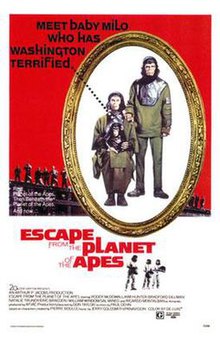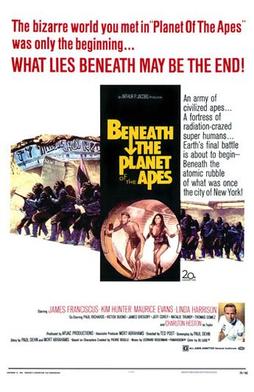
Beneath the Planet of the Apes is a 1970 American science fiction film directed by Ted Post from a screenplay by Paul Dehn, based on a story by Dehn and Mort Abrahams. The film is the sequel to Planet of the Apes (1968) and the second installment in the original Planet of the Apes film series. It stars James Franciscus, Kim Hunter, Maurice Evans, and Linda Harrison, and features Charlton Heston in a supporting role. In the film, another spacecraft arrives on the planet ruled by apes, carrying astronaut Brent (Franciscus), who searches for Taylor (Heston).

Kim Hunter was an American theatre, film, and television actress. She achieved prominence for portraying Stella Kowalski in the original production of Tennessee Williams' A Streetcar Named Desire, which she reprised for the 1951 film adaptation, and won both an Academy Award and a Golden Globe Award for Best Supporting Actress.

Roderick Andrew Anthony Jude McDowall was a British and American actor, whose career spanned over 270 screen and stage roles across over 60 years. Born in London, he began his acting career as a child in his native England, before moving to the United States at the outbreak of World War II. He achieved prominence for his starring roles in How Green Was My Valley (1941), My Friend Flicka (1943), and Lassie Come Home (1943). Unlike many of his contemporaries, McDowall managed to transition his child stardom into adulthood, and began to appear on Broadway as well as in films, winning a Tony Award for his performance in Jean Anouilh's The Fighting Cock. For portraying Octavian in the historical epic Cleopatra (1963), he was nominated for a Golden Globe Award.

La Planète des singes, known in English as Planet of the Apes in the US and Monkey Planet in the UK, is a 1963 science fiction novel by French author Pierre Boulle. It was adapted into the 1968 film Planet of the Apes, launching the Planet of the Apes media franchise.
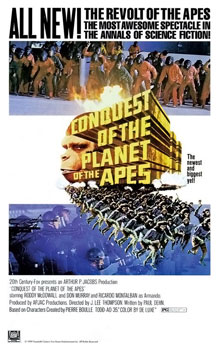
Conquest of the Planet of the Apes is a 1972 American science fiction film directed by J. Lee Thompson and written by Paul Dehn. The film is the sequel to Escape from the Planet of the Apes (1971) and the fourth installment in the original Planet of the Apes film series. It stars Roddy McDowall, Don Murray, Ricardo Montalbán, Natalie Trundy, and Hari Rhodes. In the film, set in a world that has embraced ape slavery, Caesar (McDowall), the son of the late simians Cornelius and Zira, surfaces out of hiding from the authorities and prepares for a rebellion against humanity.
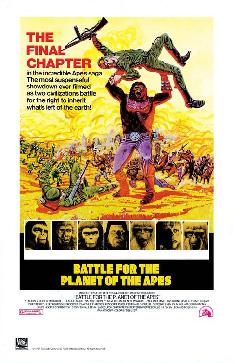
Battle for the Planet of the Apes is a 1973 American science fiction film directed by J. Lee Thompson from a screenplay by John William Corrington and Joyce Hooper Corrington, based on a story by Paul Dehn. The film is the sequel to Conquest of the Planet of the Apes (1972) and the fifth and final installment in the original Planet of the Apes film series. It stars Roddy McDowall, Claude Akins, Natalie Trundy, Severn Darden, Lew Ayres, Paul Williams, and John Huston. In the film, after conquering the oppressive humans, Caesar (McDowall) tries to keep the peace amongst the humans and apes, but uprisings endure.

Return to the Planet of the Apes is a 1975 American animated television series based on the 1968 film Planet of the Apes and its sequels, which were, in turn, based on the 1963 novel of the same name by Pierre Boulle. Unlike the film, its sequels, and the 1974 live-action television series, which involved a primitive ape civilization, Return to the Planet of the Apes depicted a technologically advanced society, complete with automobiles, film, and television; as such it more closely resembled both Boulle's original novel and early concepts for the first Apes film which were changed due to budgetary limitations in the late 1960s.
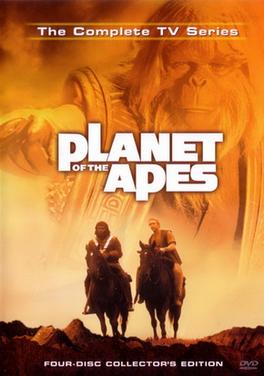
Planet of the Apes is a 1974 American science fiction television series that was broadcast on CBS. The series features Roddy McDowall, Ron Harper, James Naughton, and Mark Lenard. It is based on the 1968 film of the same name and its sequels, which were, in turn, based on the 1963 novel Planet of the Apes by Pierre Boulle.
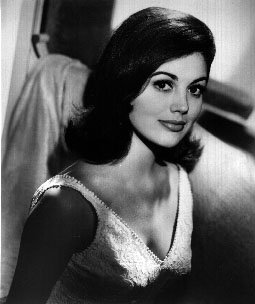
Linda Melson Harrison is an American television and film actress. She played Nova in the science fiction film classic Planet of the Apes (1968) and the first sequel, Beneath the Planet of the Apes; she also had a cameo in Tim Burton's 2001 remake of the original. She was a regular cast member of the 1969–70 NBC television series Bracken's World. She was the second wife of film producer Richard D. Zanuck ; her youngest son is producer Dean Zanuck.

Planet of the Apes is a 1968 American science fiction film directed by Franklin J. Schaffner from a screenplay by Michael Wilson and Rod Serling, loosely based on the 1963 novel by Pierre Boulle. The film stars Charlton Heston, Roddy McDowall, Kim Hunter, Maurice Evans, James Whitmore, James Daly, and Linda Harrison. In the film, an astronaut crew crash-lands on a strange planet in the distant future. Although the planet appears desolate at first, the surviving crew members stumble upon a society in which apes have evolved into creatures with human-like intelligence and speech. The apes have assumed the role of the dominant species and humans are mute creatures wearing animal skins.

Planet of the Apes is a 2001 American science fiction adventure film directed by Tim Burton from a screenplay by William Broyles Jr., Lawrence Konner, and Mark Rosenthal. The sixth installment in the Planet of the Apes film series, it is loosely based on the 1963 novel of the same name by Pierre Boulle and serves as a remake of the 1968 film version. The film stars Mark Wahlberg, Tim Roth, Helena Bonham Carter, Michael Clarke Duncan, Kris Kristofferson, Estella Warren, and Paul Giamatti. It tells the story of astronaut Leo Davidson (Wahlberg) crash-landing on a planet inhabited by intelligent apes. The apes treat humans as slaves, but with the help of an ape named Ari, Leo starts a rebellion as he seeks to return.

Planet of the Apes is an American science fiction media franchise consisting of films, books, television series, comics, and other media about a post-apocalyptic world in which humans and superintelligent apes clash for control. The franchise started with French author Pierre Boulle's 1963 novel La Planète des singes, translated into English as Planet of the Apes or Monkey Planet. Its 1968 film adaptation, Planet of the Apes, was a critical and commercial hit, initiating a series of sequels, tie-ins, and derivative works. Arthur P. Jacobs produced the first five Apes films through APJAC Productions for distributor 20th Century Fox; following his death in 1973, Fox controlled the franchise.

Planet of the Apes is a 2001 action-adventure video game in the Planet of the Apes franchise. The franchise's first video game, it was released as a tie-in to the 2001 Planet of the Apes film, though the plot is inspired by Pierre Boulle's 1963 novel and the 1968 film adaptation. Fox Interactive contracted Visiware to develop the game for Windows and PlayStation and partnered with Ubi Soft as co-publisher. Torus Games developed a Game Boy Advance and Game Boy Color versions, which are based on the 1968 film and its 1970 sequel.

Star Trek/Planet of the Apes: The Primate Directive is a five-issue crossover comic book series produced in partnership by IDW Comics and Boom! Studios and released between December 2014 and April 2015. The series was written by brothers Scott and David Tipton, with artwork by Rachael Stott, her debut work. The Primate Directive combine elements and characters from the original Star Trek series and the original Planet of the Apes film series. It features Captain James T. Kirk seeking to prevent the Klingons from installing a puppet gorilla government on the planet, which requires them working with various Apes characters such as George Taylor, Cornelius and Zira.
Green Lantern on-the Planet of the Apes is a 2017 comic book series.
Tarzan on the Planet of the Apes is a 2016 comic book miniseries combining the Tarzan and Planet of the Apes media franchises.
Planet of the Apes: Visionaries is a comic book based on the Rod Serling script for the first Planet of the Apes movie.

Caesar is a fictional character in the Planet of the Apes franchise. He is the leader of the apes in both the original and reboot series. Caesar is portrayed by Roddy McDowall in Conquest of the Planet of the Apes (1972) and Battle for the Planet of the Apes (1973); his likeness is reprised in the comic series Tarzan on the Planet of the Apes (2016). Andy Serkis portrayed the character in the reboot series, consisting of Rise of the Planet of the Apes (2011), Dawn of the Planet of the Apes (2014), and War for the Planet of the Apes (2017).
